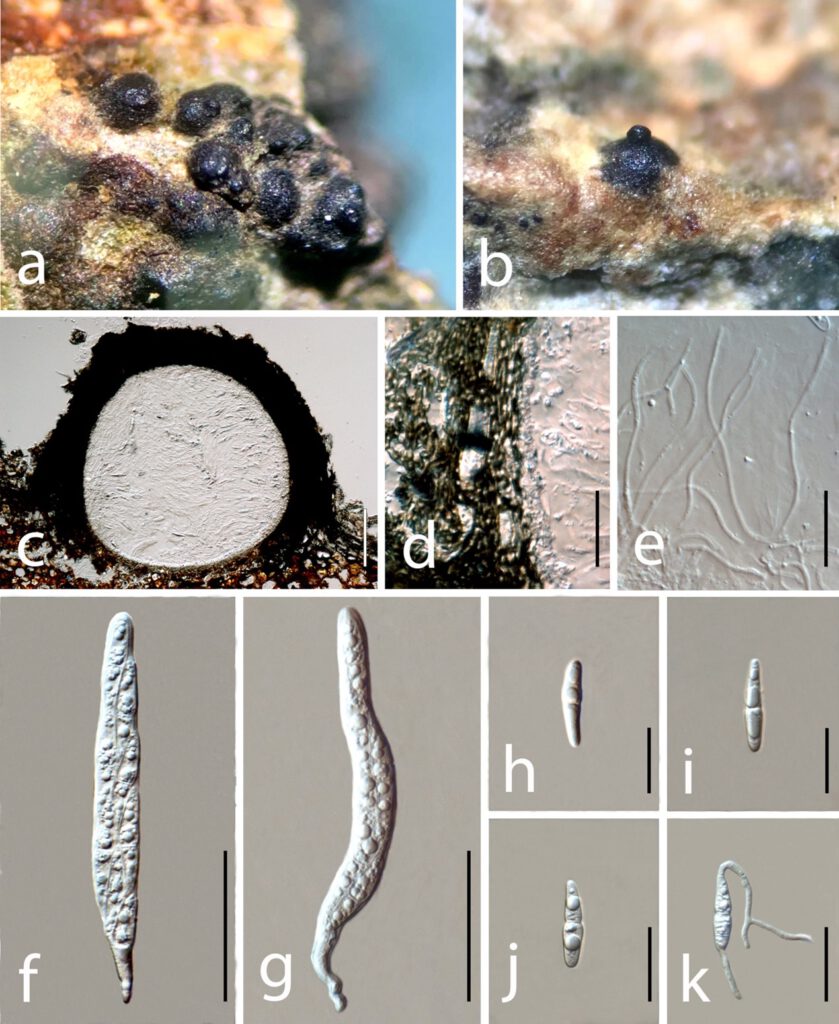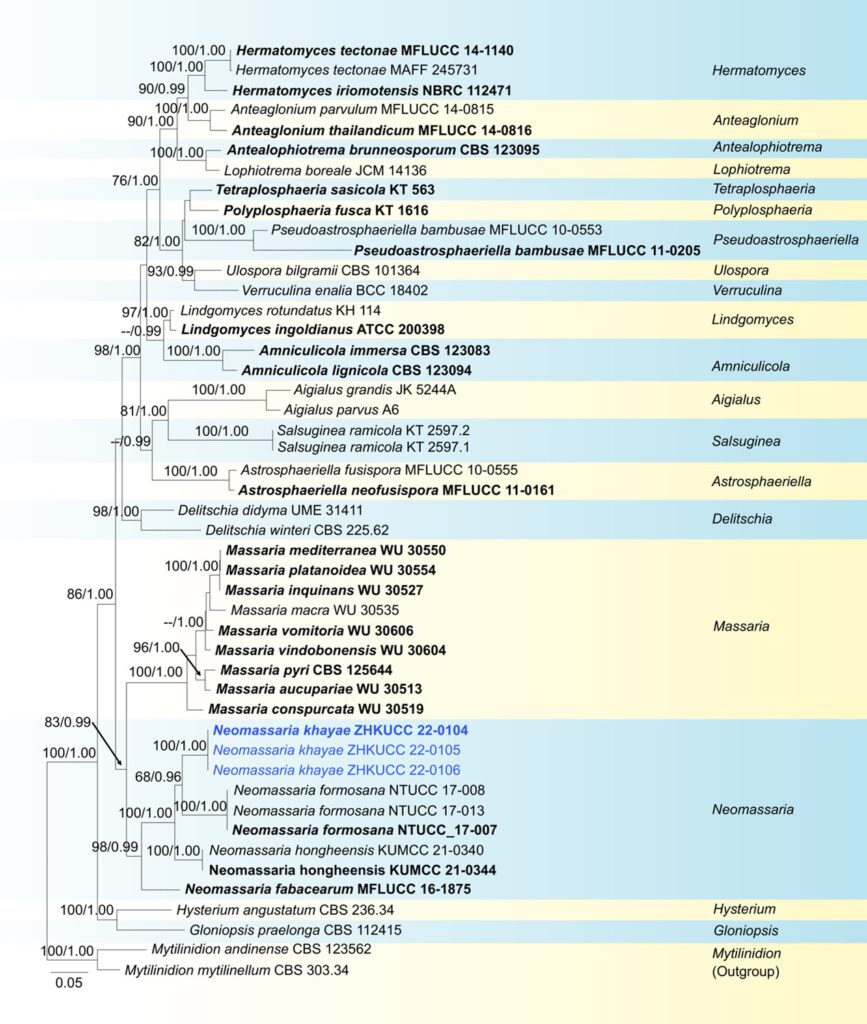Neomassaria khayae, Y.H. Yang, C.F. Liao, Manawas., & K.D. Hyde, sp. nov. (FIGURE 2)
MycoBank number: MB; Index Fungorum number: IF; Facesoffungi number: FoF 12675;
Etymology: In reference to the plant genus from which it was isolated (Khaya).
Holotype: ZHKU 22-0055
Saprobic on dead trunk of Khaya senegalensis. Sexual morph: Ascomata 300–600× 400–600 μm (x̅ = 430 × 500 μm, n = 13), semi-immersed on host tissue, some solitary, some gregarious, globose to subglobose, carbonaceous, uniloculate, dark brown to black. Ostioles 40–80 µm (x̅ = 60 µm, n = 7) diam, papillate, at the central, the epiphyseal fills the entire ostiolar canal, black. Peridium 20–100 μm (x̅ = 60 μm, n = 30) wide, thick-walled, outer layer comprising 3–6 layers of brown to dark brown thick-walled textura angularis cell, inner layer comprising of thin and hyaline cells, outer layer fuses with the host. Hamathecium 1–2 μm diam (x̅ = 1 μm, n = 21), unbranched, filamentous, aseptate, between the asci and at the apex, trabeculate pseudoparaphyses are coated with a gelatinous substance. Asci 100–150 × 15–20 μm (x̅ = 122 × 12 μm, n = 30), 8-spored, apically rounded, fissitunicate, with an ocular chamber, cylindrical or clavate, with a bulbous short pedicel. Ascospores 25–35 × 2–8 μm (x̅ = 30 × 5 μm, n = 30), hyaline, biseriate, 1–2 septate, slightly constricted at the septum, fusiform to ellipsoid, tapering from the middle to both ends, surrounded without a mucilaginous sheath, smooth-walled, mature ascospores contain 2–4 distinct refractive oil globules. Asexual morph: Not observed.
Culture characteristics – Ascospores germinated on PDA within 24 hours at 25 °C, colonies on PDA reaching up to 20 mm diam after three weeks at 25 °C. Above umbonate, colonies surface has black or grey irregular ring stripes, dense, slightly raised, surface not smooth, with cottony texture, the margin is irregular with crenate, brown in the center, edges from inside to outside ollvnceous black to pale brown. The reverse is dark brown to pale brown at the margin, and black in the center.
Material examined – China, Guangdong Province, Guangzhou City, Haizhu District, Zhongkai University of Agriculture Engineering (23°6′32″ N, 113°16′37″ E, alt. 20 m). On the dead leaves of Khaya senegalensis (Desr.) A. Juss. (Meliaceae), 27 July 2021, YH. Yang & CF. Liao, Neomassaria khayae (ZHKU 22-0055, holotype), ex-type living culture ZHKUCC 22-0104, living cultures ZHKUCC 22-0105, ZHKUCC 22-0106.
Notes – In the multigene (LSU, SSU, rpb2 and tef1-α) phylogenetic analyses of Neomassaria, three isolates obtained in this study (ZHKUCC 22-0104, ZHKUCC 22-0105, and ZHKUCC 22-0106) formed a distinct lineage to N. formosana with 68% ML, 0.96 BYPP statistical support. Morphologically, our collection is similar to Neomassaria formosana by cylindrical or clavate asci, transparent, with an ocular chamber, ascospores fusiform to ellipsoid, refractive oil globules in each ascospore, surrounded without a mucilaginous sheath (Ariyawansa et al. 2018). However, N. khayae have longer asci (90–160 × 15–19 μm) and ascospores (25–35 × 2–8 μm). Ascospores are with 1–2 septa not distinctly curved, and hamathecium is aseptate. Moreover, N. khayae is distinguished from the type species N. fabacearum by N. khayae surrounded without a mucilaginous sheath, ascospores contain refractive oil globules, while with a sheath around the ascospores and no refractive oil globules of N. fabacearum. In addition, in the pairwise sequence comparison between N. khayae and N. formosana for different genes, 19 base pair differences (2.2%) were in the LSU sequences out of 846 nucleotides, seven base pair differences (0.5%) in the SSU sequences out of 1355 nucleotides, 142 base pair differences (13.99%) in the rpb2 sequences out of 1015 nucleotides in the gene sequence of rpb2 and 43 base pair differences (5.94%) in the tef1-α sequences out of 723 nucleotides were observed. Therefore, based on both morphological and phylogenetic evidence, N. khayae is described as a new species.
| TABLE 3. Morphology, host, and geographical information of Neomassaria species. | ||||
| species
Sexual morph |
Neomassaria formosana | Neomassaria fabacearum | Neomassaria hongheensis | Neomassaria khayae |
| Ascomata(µm) | 100–200 × 100–370 | 200–220 × 130–150 | 160–230 × 220–300 | 310–560 × 380–590 |
| Ostioles(µm) | 20–38 | 10–20 | – | 40–80 |
| Peridium(µm) | 13–40 | – | 30–50 | 20–110 |
| Hamathecium(µm) | 1–2, septate | 1–2, septate | 1–2, septate | 1–2, aseptate |
| Asci(µm) | 80–125 × 14–17 | 65–75 × 10–15 | 90–120 × 8–12 | 90–160 × 15–19 |
| Ascospores(µm) | 20–30 × 3–7 | 18–20 × 5–6 | 14–17 × 4–8 | 25–35 × 2–8 |
| Other | surrounded without a mucilaginous sheath, Ascomata coriaceous, contain refractive oil globules | surrounded by hyaline gelatinous sheath, Ascomata coriaceous, does not contain refractive oil globules | surrounded without a mucilaginous sheath, Ascospore rounded at both ends or acute at the base, does not contain refractive oil globules | surrounded without a mucilaginous sheath, Ascomata carbonaceous, contain refractive oil globules |
| Host/Habitat and Location | Rhododendron sp.
China (Taiwan) |
Hippocrepis emerus (L.) Italy | Mangifera indica China (Yunnan) | Khaya senegalensis China (Guangdong) |
| Reference | Ariyawansa et al. (2018) | Hyde et al. (2016) | Yang et al. (2022) | This study |
Host and location information of taxa are mainly from (Hyde et al. 2016; Ariyawansa et al. 2018; Yang et al. 2022). Remarks: the symbol “-” denotes no information available

FIGURE 2. Neomassaria khayae (ZHKU 22-0055, holotype). a–b Appearance of ascomata on the l host. c Vertical section of ascoma. d Section through peridium. e Paraphyses. f–g Asci. h–j Ascospores. k germination spore. Scale bars: c, f–j = 50 μm, d, e, h–k = 20 μm.

FIGURE 1. Best scoring RAxML tree based on a combined dataset of the LSU, SSU, rpb2, and tef1-α partial sequences. The tree is rooted in Mytilinidion andinense (CBS 123562) and Mytilinidion mytilinellum (CBS 303.34). Bootstrap support values for maximum likelihood (ML) ≥ 75% and Bayesian Probability (BYPP) ≥ 0.95 are indicated above the branches. Ex-type strains are in bold, and newly generated sequences are in blue.
